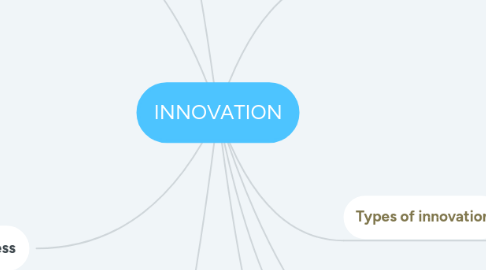
1. Process of value creation
1.1. Inputs
1.1.1. Resources/Capabilities
1.2. Process
1.2.1. Patern of activities
1.3. Externalities/Interactions
1.3.1. Scale/Scope/Externalities
1.4. Output
1.4.1. Value proposition
2. Innovation and nations
2.1. Global Competitiveness Index
2.1.1. Basic Requirements Subindex
2.1.1.1. Pillar1. Institutos
2.1.1.2. Pillar2. Infrastructure
2.1.1.3. Pillar3. Macroeconomic Environment
2.1.1.4. Pillar 4. Health and primary education
2.1.2. Efficiency enhancers subindex
2.1.2.1. Pillar 5. Higher education and training
2.1.2.2. Pillar 6. Goods market efficiency
2.1.2.3. Pillar7. Labor market efficiency
2.1.2.4. Pillar 8. Financial market development
2.1.2.5. Pillar 9. Technological readiness
2.1.2.6. Pillar 10. Market size
2.1.3. Innovation and sophistication factors subindex
2.1.3.1. Pillar 11. Business Sophistication
2.1.3.2. Pillar 12. Innovation
3. Innovation process
3.1. Evolution
3.1.1. Edison
3.1.1.1. Formal research on potential markets
3.1.2. Lafley
3.1.2.1. undestanding and meeting customers needs
3.1.2.1.1. Lack of technical progression
3.1.2.2. Customer at the heart on the innovation process
3.2. Perspectives
3.2.1. only seen as
3.2.1.1. strong R&D capability
3.2.1.1.1. Fails to meet users needs
3.2.1.2. breakthrough changes
3.2.1.2.1. Neglect of the potential of incremental innovation
3.2.1.3. only associated to key individuals
4. Design Thinking
4.1. Steps
4.1.1. Ideate
4.1.2. Test
4.1.3. Prototype
4.1.4. Define Process
4.1.5. Empathize
4.2. Main Techniques
4.2.1. Assume a Beginner´s Mindset
4.2.2. What? I how? I why?
4.2.3. User Camara Study
4.2.4. Interview Preparation
4.2.5. Empathy Map
4.2.6. Interview for Empathy
4.2.7. Extreme Users
4.2.8. Analogous Empathy
4.2.9. Story Share- and- capture
4.2.10. Journey Map
4.2.11. Composite Character profile
5. Four main elements in the diffusion of new ideas
5.1. The innovation, communication channels, time and social system (context)
6. Types of innovation
6.1. Greg Satel
6.1.1. Breakthrough Innovation
6.1.1.1. The problem is well defined but not the domain
6.1.2. Basic Research
6.1.2.1. The problem is not well defined and neither the domain
6.1.3. Sustaining Innovation
6.1.3.1. The problem and the skill domains are well defined
6.1.4. Disruptive Innovation
6.1.4.1. The problem is not defined but the skill domains are
6.2. Geoffrey Moore
6.2.1. 1-. Product Leadership
6.2.1.1. Disruptive Innovation
6.2.1.1.1. Application Innovaton
6.2.2. 2-. Customer Intimacy
6.2.2.1. Line - Extension Innovation
6.2.2.1.1. Enhancement Innovation
6.2.3. 3-. Operational Excellence
6.2.3.1. Value - Engineering Innovation
6.2.3.1.1. Integration Innovation
6.2.4. 4-. Category Renewal
6.2.4.1. Organic Innovation
6.2.4.1.1. Acquisition Innovation
7. Innovation concepts
7.1. As a process of doing something new
7.1.1. Imitation, inventions, discovery
7.2. As a human abilities to creative activity
7.2.1. Imagination, ingenuity, creativity
7.3. As a change in all spheres of life
7.3.1. Cultural change, social change, organizational change, political, techonological change
7.4. As commercialization of new product
7.4.1. Something new, conduit of change, a process, a value driver, invention
8. Innovativeness (Diffusion theory)
8.1. Innovation
8.1.1. Relative advantage, compatibility, complexity, trialability and observability.
8.2. Communication channles
8.2.1. Mass media channels and interpersonal channels
8.3. Time
8.3.1. Innovativeness:
8.3.1.1. Innovators, early adopters, early majority, late majority and laggards
8.4. Social system (contex)
8.4.1. Set of interrelated units that are engaged in joint problem-solving to accomplish a common goal
9. Cocreating value with customers
9.1. Changing the role of customers in services
9.1.1. Customization
9.2. Tacit knowledge
9.2.1. Communicaation: supplier-customer
9.2.1.1. Let customers provide the info directly
9.2.2. strategic advantage
9.2.2.1. Competitive advantage for companies

